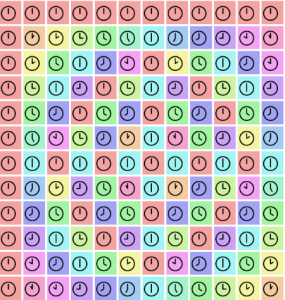
Welcome to the 131st edition of the Carnival of Mathematics, a monthly blogging carnival which scoots its way round the internet, rounding up maths-related blog posts from the month of January.
As is traditional, I’ll start with some mathematical facts about the number 131. Not only is it a prime number, it’s determinedly so: if you reverse it, it’s still prime (so it’s a Palindrome Prime), and if you permute the digits in any order, it’s still prime (so it’s an Absolute Prime). It can also be written as a sum of three consecutive primes: $131 = 41+43+47$.
On with the Carnival!
Can you believe that a dodecahedron folds into a cube?
Mike Lawler, over at Mike’s Math Page, is always looking for new ways to share his enjoyment of mathematics with his kids. He spotted Simon Gregg’s blog post from 2014, in which he’s made a cube that transforms into a dodecahedron – and was inspired to try to recreate it using zometool.
Amazing maths from mathematicians to share with kids
Mike’s also rounded up some of his favourite examples of mathematicians using cool maths to inspire kids – which I have to say includes some excellent choices ok fine my fold and cut video is in there.
How much would you pay for a 20% discount?
Patrick Honner, who blogs at MrHonner.com, has discovered a quirk in his local OfficeMax’s sale – they offer a 20% discount when you buy a certain number of items – meaning a wily shopper can actually save money by buying more things…

Math Becomes Art in Byrne’s 1847 colourful Euclid
The artwork on this site has been inspired by Oliver Byrne’s amazing 1847 illustrated edition of Euclid’s Elements, in which his beautiful coloured illustrations brought to life Euclid’s beautiful geometry. This blog post from the Rare Books section at the library at St Andrews includes some lovely photos, and clever animations, from Rare Books librarian Daryl Green.
The biggest maths news this month was of course the discovery of a new Mersenne prime, $M_{49} = 2^{74,207,281} – 1$. As well as our own round-up of the news, here’s a few posts on the topic.
The Largest Known Prime Number
Veteran maths blogger Evelyn Lamb has written her thoughts on the new incredible indivisible integer, over at Slate.PSA: Do Not Use the New Prime Number for RSA Encryption
Evelyn’s also blogged in her own column at Scientific American, about how primes are used in RSA encryption – and why using a famous one is probably a bad plan.Why I can’t get excited about the new largest known prime
Colin Beveridge, who blogs at Flying Colours Maths, doesn’t necessarily share everyone else’s enthusiasm for the new oversized divisor, and he explains why.
A new way to read (and print) double-sided paper
Computer scientist Brent Yorgey, who blogs at The Math Less Travelled, has an inspired alternative to back-to-back printing. I wonder if it’ll catch on?
What’s your favourite number number? The top ten best number songs
Greetings, pop-pickers! Maths-botherer Alex Bellos has rounded up some numerical melodies from the charts of days past.
John Conway: Genius Behind The Numbers
Siobhan Roberts’ new book, Genius at Play, is a fascinating autobiography of the mathematician John Conway. This piece at 52-insights is a lovely interview with Conway by Roberts.
Number factoids
Brian, who blogs at bit-player, has satisfied his own curiosity about how number factoid websites like numbersaplenty.com and numberworld.info work – by building his own. Whack in your favourite integer (below $10^{15}) and it’ll hit you up with some facts.

Visualising the DFT Matrix
Over on his blog, John D Cook has found a nice way to visualise the discrete fourier transform matrix, using a range of colours, and unicode images of a clock.
Irrational Sunflowers
Meanwhile, over on Calculus 7, there’s a nice representation of rational and irrational numbers using polar angles, resulting in sunflower-like constructions.
A New Solid of Constant Width
The Wolfram Blog hosts many excellent maths posts, including this one from Ed Pegg, who’s discovered a new solid of constant width, with tetrahedral symmetry.
And finally, in honour of Pancake day (which wasn’t in January but just squeaked by the submission deadline) – as well as my Open Season post on Pancake Flipping, the Sheffield University Made-Up Media Formula squad Maths Society has come up with the “formula for the perfect pancake“, known to many as the “formula for the volume of a cylinder”, which they are actually given credit for devising – although I’m pretty sure that was someone else.
It is an admirable and apparently genuine attempt to get people calculating stuff, although it’s presented in the same ‘boffins crack formula’ style which makes maths seem so opaque to non-mathematicians. They have, however, created a handy pancake recipe calculating gadget, based on Delia Smith’s recipe, which gives you your quantities to the nearest hundredth of an egg. Now that’s perfection.
I hope you’ve enjoyed this edition of the Carnival of Mathematics, and keep an eye on our Carnival of Maths page for more! If you see any mathematical nuggets of bloggy, videoey or otherwise internetly goodness, please submit them. The next Carnival will be hosted by Brent at The Math Less Travelled.
This is a great collection of articles you have here, all of them are really interesting.